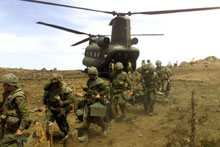The U.S. Military Is in Real Trouble
 Our 30-year old all-volunteer Army is crucially close to being broken.
Our 30-year old all-volunteer Army is crucially close to being broken.
Never in the history of the post-Vietnam volunteer Army has such a beaten up and over-tasked force had to sustain itself in the face of ever-expanding requirements and constantly accelerating deployment tempos that we see today.
The quality of our force is suffering. Anybody who denies that fact is either blind or ignorant. If the military is not bolstered, very soon, with an infusion of smart, well-trained, and highly-motivated volunteers, the force will suffer even more.
Where do we start pointing the finger? Do we just sweep this under the rug, chin up, and stop our bellyaching? Not on your life, because if it is not cured now, it is going to fester into a quandary that will present the United States with an unprecedented challenge in this time of war.
A fix is needed and it begins with the Army personnel system. This is a system that has been in place since the waning days of our two-decade involvement in Vietnam.
At that time our military forces were experiencing a virtual meltdown due to the massive conscription of young men from generally “less than affluent” America. President Lyndon Johnson deferred the politically sensitive issue of mass mobilizations of National Guard units for duty in Vietnam and further drew the fighting force from the average kid back on the block.
His own guilt for his mismanagement of the Vietnam War haunted him to the point of refusing to run for a second term and a flat refusal to accept a Democratic nomination if one was forthcoming. It was time for a change and it came with the election of President Richard M. Nixon.
Shortly after Nixon occupied the White House, he embraced a quote by an esteemed military leader. General Maxwell Taylor, the former Army Chief of Staff and Chairman of the Joint Chiefs of Staff, had said “Although the Army had been sent to Vietnam to save that nation, it had to be withdrawn in order to save the Army.”
In response, Nixon promised to get the United States’ combat forces out of Vietnam and end the draft. He accomplished both of those goals by the end of his first term. In July 1973, the Pentagon established the all-volunteer force. After several years of inevitable challenges and start-up problems, by the early 1980s the U.S. armed forces became, without a doubt, the most professional, highly educated, and highly qualified military force that the nation had ever fielded.
We maneuvered through the 1980s, gaining our “sea-legs” with Team Spirit Exercises in South Korea, annual REFORGER exercises in Europe, and numerous other training and quasi-real world, sub-exercises and military maneuvers around the globe. Our forces grew wise in the ways of the Central American guerrilla and we began to see the former Yugoslavia as a future area of military focus.
Peacekeeping duties in certain areas in the Balkans, and in the Sinai, remained sustained requirements. Many reservists were called up to bolster the active force. Shortly after Iraq invaded Kuwait in 1990, DoD was forced to call up more reserve and National Guard troops to meet the requirements of Operation Desert Storm.
To the credit of the reserve and National Guard units and their soldiers, volunteerism was largely back in style. Augmentation and call-ups seemed to proceed well back then. So why are we in trouble now?
The answer is simple! During the first Gulf War, and in line with other global peacekeeping duties, our reserve and National Guard soldiers were not kept on active duty for more than six months at a stretch. Active duty soldiers who were sent on peacekeeping missions were also rotated back to home-station after six months and they were not deployed overseas or into hazardous duty missions until they had spent at least a year at their home-station.
But in the aftermath of 9/11, the reserve component mobilization system began to beak down.
Only nine months earlier Secretary of Defense Donald H. Rumsfeld had taken over at The Pentagon. In an initial announcement, Rumsfeld said that his mandate was to transform the military by the incorporation of the absolute latest technology in the development and acquisition of weapons systems.
Rumsfeld, however, failed to address the issue of the sense of balance between active-duty and reserve soldiers. This rapidly became a critical issue once the nation went to war in Afghanistan and later in Iraq.
Thomas Hall, the Assistant Secretary of Defense for Reserve Affairs, told reporters that the Pentagon’s civilian and military leadership has been aggressively studying this issue for almost two years. To this point, apparently, not much has resulted from all of that studying. There are consequences that are directly attributable to the lack of results.
The reality of the present day reserve forces is that their level of military responsibility has hardly changed since 1973.
According to the Defense Department, reserve soldiers represent 97 percent of all the military's civil affairs units, 70 percent of all engineering units, 66 percent of all military police, and stunningly enough – 50 percent of actual combat forces.
All this is further compounded by the fact that the active-duty Army has shrunk to 480,000 full time green-suiters. The Army now represents only 34 percent of the total U.S. armed forces.
The reality does not stop there. Due to poor planning, lack of foresight, and near catastrophic shortcomings in the forecasting of the strategic picture requirements in post-war Iraq, the situation has seriously worsened.
The demand on our soldiers is compounded by the fact that the United States has been woefully unable to secure sizeable military personnel and equipment contributions from other nations for Iraq. The resulting burden of stabilizing Iraq is being borne on the backs of our exhausted soldiers.
The Army today is ominously overstretched. Currently there are approximately 370,000 Army soldiers deployed in 120 countries around the world.
The Army has 33 combat brigades, of which 24 are currently engaged in operations outside the continental United States. That constitutes roughly 74 percent of the Army’s combat brigades. The vulnerability of this imbalance can be ascertained in Korea: What could we do if a new war erupts there?
For those with minimal awareness of military planning, the brigade figures translate directly into the fact that our combat units will be subject to subsequent or back-to-back deployments. At the very least, just about all deployed soldiers will have their hazardous duty tours extended, usually just when they thought they might be coming home.
A few examples that warrant attention consist of the First Brigade of the 82nd. Airborne Division. The brigade was sent to Iraq in January 2004, when it had just returned to home station only five months earlier from duty in Afghanistan.
The 3rd Infantry Division – the unit that liberated Baghdad in early April of last year – had its tour in Iraq extended no less than five times. Some frustrated soldiers of the 3rd Infantry ran afoul of contemporary discipline standards when they were quoted as making less than proper statements to reporters about the secretary of defense.
Notwithstanding, in July 2003, Central Command chief Gen. John Abizaid announced that all Army units would have to spend a full year in Iraq, which is double the normal tour for peacekeeping duties.
Yet another shameful result of the lack of planning is that many National Guard and reserve forces have been mobilized without proper notification timelines. They have been kept on active duty far longer than anyone would have anticipated. These part-time soldiers have also been sent to hotspots such as Iraq and Afghanistan without effective and necessary time-phased training.
For example, a contingent of the Michigan National Guard was sent to Iraq with only 48 hours notice. The 115th Military Police Battalion of the Maryland National Guard has been mobilized three times in the past two years. By the end of their third tour most members of the unit will have had actually remained on active duty for 18 months. How can this happen?
Don't ask Lt. Gen. James Helmly, the commander of the Army Reserve. This is the commander who went on record with the press saying that a reserve soldier should be given at least 30 days notice before being mobilized and those reservists should not be kept on duty for more than 9 to 12 months in a 5–6 year timeframe.
Draw your own conclusions on veracity when it comes to the Army Reserve chief.
Another ripple effect of the failure to reorganize the personnel structure goes right to the sinew of many American communities and municipalities.
Many of the reservists who have been called up without proper notice or who are being kept on duty too long are police officers, firefighters, and paramedics in their civilian lives. Many serve as initial responders who are vital to the safety and security of their communities and their residents. In one West Virginia State Police unit, 25 percent of the troopers have been mobilized and are serving in the military.
The worsening situation also affects overall military readiness. From my corner of the foxhole, this is where the rubber meets the road in the need to address personnel reorganization and to confront the problems afflicting our military forces.
In fiscal year 2003, the Army had to cancel 49 of its scheduled 182 training exercises. DoD admits that the four Army Divisions returning from Iraq in the first five months of 2004 will not be combat-ready again for at least six months. Pentagon officials admit that the soldiers’ equipment has worn down and their war-fighting skills have withered while they were doing police work. So out of a total of ten divisions in the whole U.S. Army, four can’t do anything war-related for half a year!
The cumulative effect of this deterioration on troopers' morale cannot be underestimated.
Following a recent survey of U.S. soldiers in Iraq by the military newspaper Stars & Stripes, some analysts have concluded that the Bush administration's approach to Iraq risks doing to the All-Volunteer Force what Vietnam did to the draft.
The survey, which polled thousands of troops, found that 40 percent of recipients said their missions in Iraq had little or nothing to do with what they had trained for. Perhaps even more foreboding, half the soldiers who were surveyed indicated that they will not reenlist when their tours end or when the Pentagon lifts the stop-loss order currently in effect that has prevented over 24,000 active duty soldiers and over 16,000 reservists from leaving the service.
This week I spoke over twenty Army NCOs, all recently returned from Iraq and Afghanistan duty. Ranging in rank from corporal to sergeant 1st class, all but two said they intend to leave active service once they get the opportunity to do so. The majority added that they wish to completely sever their military ties and will not join reserve units to continue their service.
Two general officers, who have asked that they remain nameless, have both told me that it is their firm belief; that if it were not for the stop-loss policy then the total force would already be in critically severe jeopardy and it clearly could not complete its missions. Meanwhile, U.S. Army Reserve officials are pondering why they have missed their reenlistment goals for 2003.
Each of these divisions should number around 14,000 soldiers and one division should be active and the other reserve.
According to a study sponsored by retired Vice Adm. Arthur Cebrowski, these two divisions must be added to the existing Army structure. The divisions are critically important because our combat units have been run ragged installing and propping-up indigenous leaders into positions of quasi statesmanship, with American backing, and playing the role of un-invited cop-on-the-beat. These two mandates are clearly two types of missions that infantry soldiers are not trained at and should not be doing.
Finally, when one considers the present and anticipated threat to America's homeland, some hard decisions need to be made at the Pentagon.
No longer can we allow individuals with civilian jobs, and professions that are an important part of the homeland security network, to sign on with National Guard and reserve units.
Homeland defense is the basis for our national security effort. The defense of our nation, right down to the little towns in the hinterlands, requires full-time dedicated personnel manning the local effort.
Towns and cities that find themselves left with only a fraction of their police and fire departments, reduced medical staff at local hospitals, and largely absent city and town administrations, set a dangerous precedent. This is exactly where the roots of homeland defense and America's security begin.
By J. David Galland
J. David Galland is Deputy Editor of DefenseWatch Magazine. He can be reached at defensewatch02@yahoo.com.
Join PRAVDA Forum to discuss the latest developments in Iraq
Subscribe to Pravda.Ru Telegram channel, Facebook, RSS!


